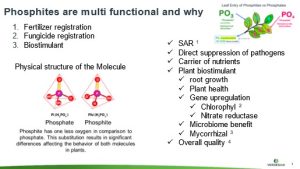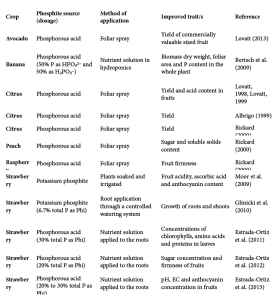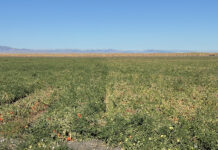Phosphite has been a controversial topic for years. Its use and benefits are argued in hundreds of research papers across the world’s scientific communities. Is it a fertilizer, a biostimulant or a fungicide? These questions are discussed in multiple university research results. I believe that if we look carefully, we can conclude phosphite serves all three functions. As with everything we do with chemicals and nutrition, we need to be aware of possible negative effects. We also need to determine how we are using the phosphite materials and the results we are seeking.
Phosphite (PO33-; Phi), a reduced form of phosphate (PO43-; Pi), is widely marketed as either a fungicide or fertilizer or sometimes as a biostimulant. Because CCAs, growers and distributors see the product marketed in all three ways, this can cause confusion. Each designated use will most likely be tied to the phenology (growth stage) of each treated crop. Timing is critical to determine which effect we are seeking. In this article, we broach the controversial topic of Phi as a biostimulant.

In Research
Many researchers believe that Phi does not attribute to the growth and health of the plant. They believe that the positive response to Phi is attributable to the disease suppression by Phi. Lovatt and Mikkelsen (2006) emphasized Phi, if used at appropriate rates, can provide stimulation to plants that may not occur with Pi. They suggested Phi is more than just a fungicide; for example, it increases floral intensity, yield, fruit size and total soluble solids. In addition, combinations of Phi and Pi ions are believed to be more effective than either Pi or Phi alone in plant assimilation (Foster et al. 1998; Young 2004).

With all my studies and visits with research teams, I believe Pi is becoming accepted by agriculture as a biostimulator. Even without a consensus on its physiological function across agriculture and horticulture, too many positive effects are evident. As long as there is sufficient Pi present, Phi continues to have a positive effect on plant metabolism. Today, Phi is emerging as a potential inductor of beneficial metabolic responses in plants as it has demonstrated its effectiveness against different stress factors and has improved crop yield and quality. Important progress has been made in the field of Phi uptake, transport and subcellular localization, and there is still a more in-depth understanding of the fundamental processes behind the effects of Phi on plant metabolism needed.
Moor et al. (2009) found the application of Phi does not affect strawberry growth or yield compared to traditional Pi fertilization, although it does increase fruit quality by activating the synthesis of ascorbic acid and anthocyanins. Similarly, Estrada-Ortiz et al. (2013) found beneficial effects of Phi on strawberry fruit quality and induction of plant defense mechanisms (Estrada-Ortiz et al., 2011, Estrada-Ortiz et al., 2012), which has also been reported by Rickard (2000) in several crop species and cultivars. Likewise, Glinicki et al. (2010) reported beneficial effects of Phi on the growth parameters of three strawberry cultivars.

As a Certified Crop Consultant and Certified Professional Agronomist, based on research studies and trials, I believe that phosphites are biostimulants. Couple that with the ability of phosphite to enter and translocate within a plant and you have a formidable tool. The following statement and sited research results confirms this:
“Phosphite has been found to display systemic effects and high chemical stability in plant tissues, though it also shows great mobility throughout the whole plant. This mobility facilitates the penetration and transport of the foliar-applied Phi to the rest of the plant, including the roots.” – Smillie et al. 1989, Brunings et al. 2015
By definition, “A plant biostimulant is any substance or microorganism applied to plants with the aim to enhance nutrition efficiency, abiotic stress tolerance and/or crop quality traits, regardless of its nutrient content.” By extension, plant biostimulants also designate commercial products containing mixtures of such substances and/or microorganisms. Research projects and results are too numerous to quote them all.



















